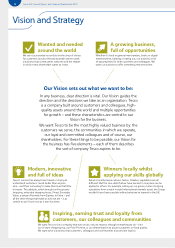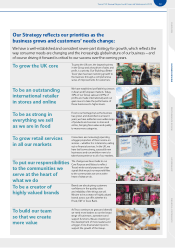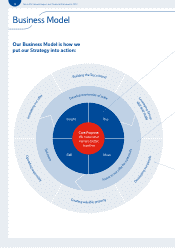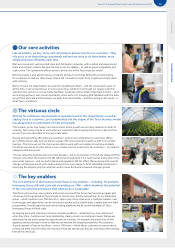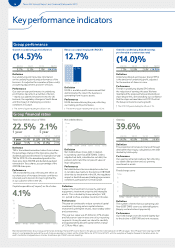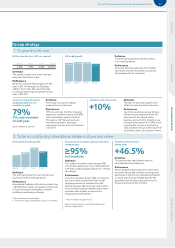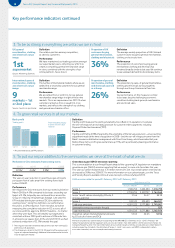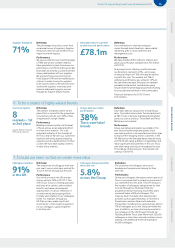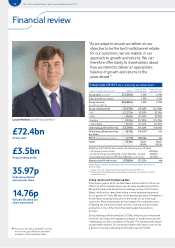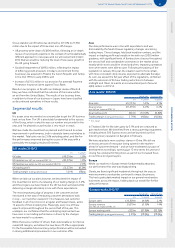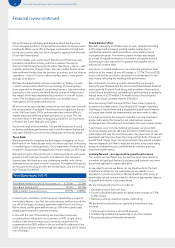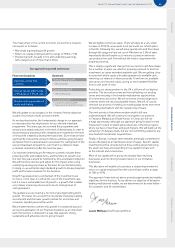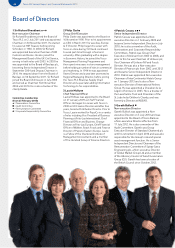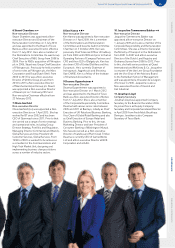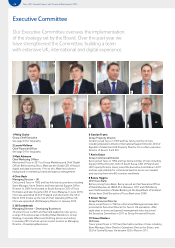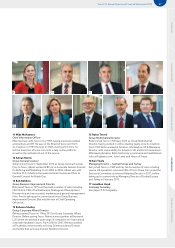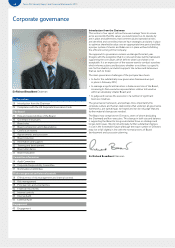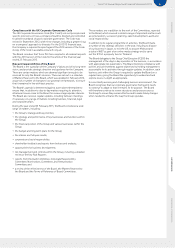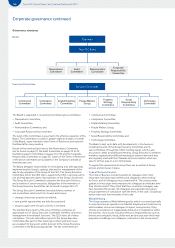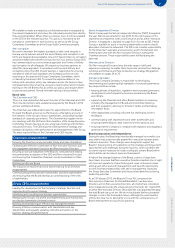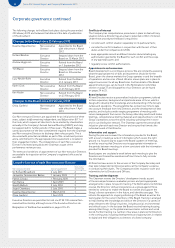Tesco 2013 Annual Report Download - page 26
Download and view the complete annual report
Please find page 26 of the 2013 Tesco annual report below. You can navigate through the pages in the report by either clicking on the pages listed below, or by using the keyword search tool below to find specific information within the annual report.
22 Tesco PLC Annual Report and Financial Statements 2013
Financial review continued
Group balance sheet
Net debt reduced by £0.2 billion year-on-year, despite the trading
profit impact and increased working capital, mainly due to
significantly reduced capital expenditure and a small increase
in property proceeds. The working capital increase was largely
as a result of regulatory impacts in a number of markets and the
shortening of order lead times for general merchandise which
reduced our creditor days.
Our return on capital employed, on a continuing operations basis
and prior to the impact of one-off charges, is 12.7%. This is a (200)
basis point decline on returns calculated on a similar basis for last
year, mainly reflecting the trading profit performance.
We continued to see strong investor demand for our property
during the year. We launched the Tesco Lotus Retail Growth Freehold
and Leasehold Property Fund along with a number of transactions
in the UK and South Korea, contributing to profits arising on property-
related items of £370 million. The market value of our property
across the Group currently exceeds £38 billion.
Since becoming Chief Financial Officer I have made it a priority
to improve our debt metrics. Resetting the UK margin, regulatory
challenges in South Korea and a disappointing profit performance
in Europe have stalled the improvements we have made to date.
It is a high priority for the Group to maintain a strong investment
grade credit rating. Our target on net indebtedness remains
unchanged and it should be achieved within the next couple of years.
Fixed charge cover is more challenging because our gross debt
has long maturity periods. We have £2 billion of debt that we can
potentially retire over the next three years. Our lower level of sale and
leasebacks will help slow down the rising rent bill. Both of these will
benefit fixed charge cover. Our improved cash flow growth will help
improve retained cash flow to adjusted net debt, a key credit rating
measure, underpinning our commitment to maintain a strong
investment grade rating.
Looking forward – our approach to growth and returns
The actions we have taken over the last two years have removed
a number of significant barriers to progress and underpin our more
disciplined approach to capital allocation.
As we adapt to ensure we deliver on our objective to be the best
multichannel retailer for our customers, we are realistic in our
approach to growth and returns. We can therefore offer clarity to
shareholders about how we intend to deliver an appropriate balance
of growth and returns in the years ahead.
We are managing the business in order to:
• Generate positive free cash flow
• Ensure a disciplined allocation of capital within a range of 3.5%
to 4% of sales
• Maintain a strong investment grade credit rating
We are therefore allocating our capital to achieve three clear
priorities:
1. Continuing to invest in a strong UK business
2. Establishing multichannel leadership in all of our markets
3. Pursuing disciplined international growth
Our performance in Hungary and Slovakia, where we enjoy two
of our strongest positions, has proved more resilient to the economic
headwinds. While our profits in Hungary continued to be held back
by the crisis tax this year, this will no longer be applied from the start
of our new financial year.
In some markets such as the Czech Republic and Poland, we saw
increased competitive activity, with those retailers focused on
discount small formats faring much better than those – like us – with
a greater proportion of larger stores. Our own smaller format stores
have performed better than the business as a whole, and our dotcom
operations – now in 13 cities in these markets alone – have grown
strongly since launch.
We have faced particularly intense competition in Turkey, in a year
in which we have retrenched from our strategy of pursuing large
store expansion to the east of our existing business. Like many other
businesses in the country, we faced intense cost-price inflation and
the impact of this was exacerbated by a number of one-off, historic
issues. The resulting losses contributed to our shortfall versus
expectations for European performance.
All of our businesses undertake a value in use test each year to justify
the carrying value of goodwill. Those businesses acquired in Europe
in the 1990s and early 2000s unfortunately face a more difficult
market today and different growth prospects as a result. This led
to a write-down in the value of acquired goodwill for our businesses
in Poland, the Czech Republic and Turkey.
Our priority in all of these markets is to get the businesses focused
on driving underlying performance and it is for this reason that we will
only open 400,000 sq ft of net new selling space in the year ahead.
Tesco Bank
We were pleased to complete the final stages of migration of Tesco
Bank early in the financial year and to be able to get back to focusing
on marketing our existing products. Our programme of new products
resumed in August with mortgages and more recently, our ISA range.
We made progress through the year in banking products, with good
growth in both customer accounts and balances. Our insurance
business was held back by a very challenging market, with strong
downward price pressure in motor insurance. Throughout this period,
we focused on ensuring we offer the best products and prices to our
loyal Clubcard customers.
Tesco Bank results 2012/13
£m % growth
Tesco Bank revenue (exc. VAT, exc. impact of IFRIC 13) £1,021m (2.2)%
Tesco Bank trading profit £191m (15.1)%
Trading margin (trading profit/revenue) 18.71% (284)bp
In recent years, the Bank’s profit has been impacted by a couple of
non-trading factors – the first, fair value releases and the second, the
run-off of our legacy insurance agreement with Direct Line Group.
Before these, profits grew well and are up 13% with a particularly
pleasing performance in customer lending.
In line with the rest of the industry, we have been proactively
consulting more widely with our customers on PPI. In light of this
contact, it has become necessary to increase our provision for
compensation by £(85) million in the second half. In addition to the
£(30) million provision in the first half, this takes us to a £(115) million
one-off charge.


